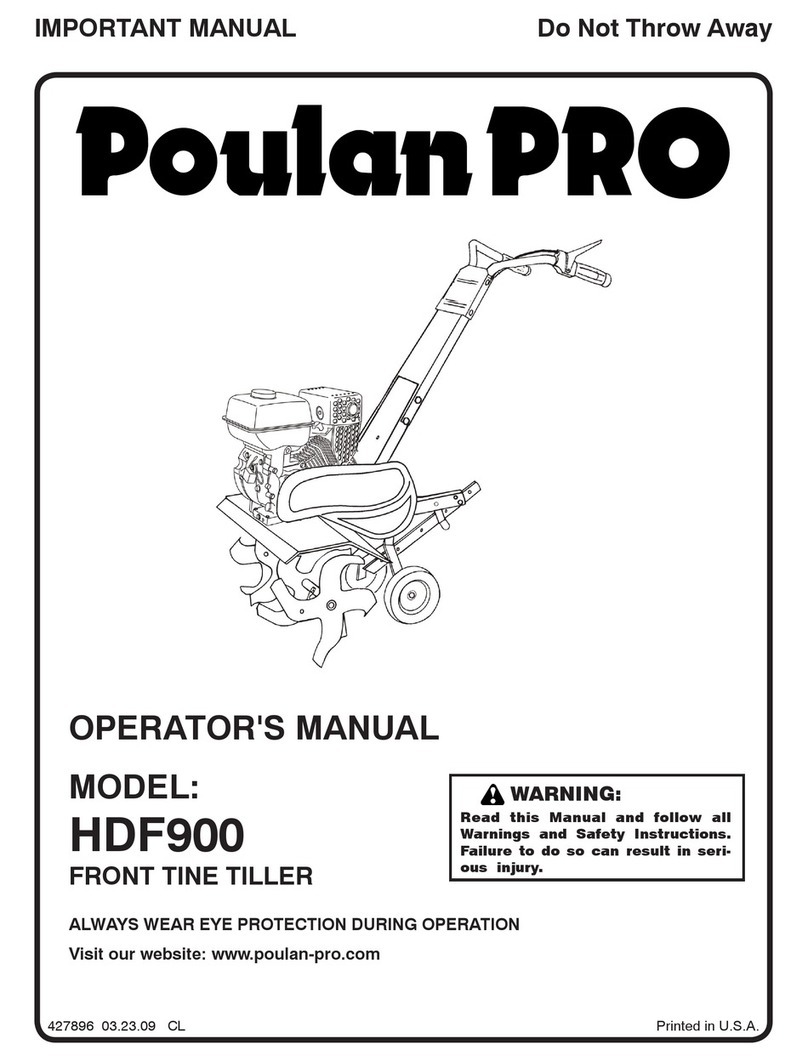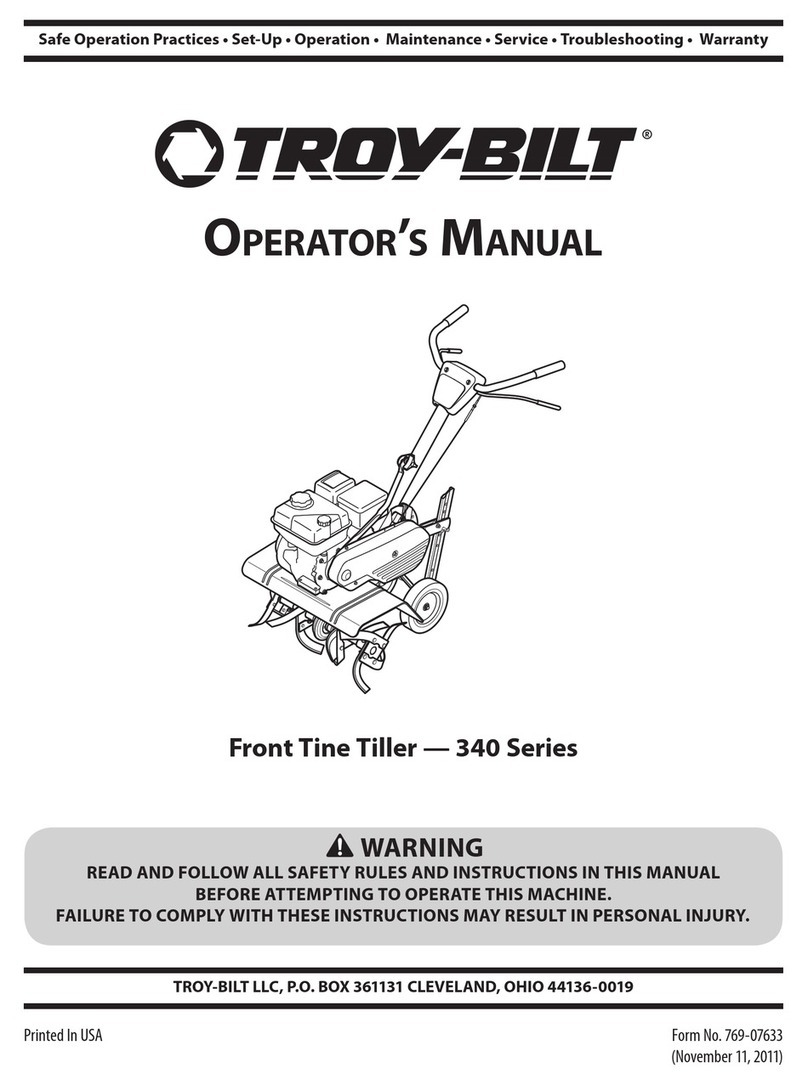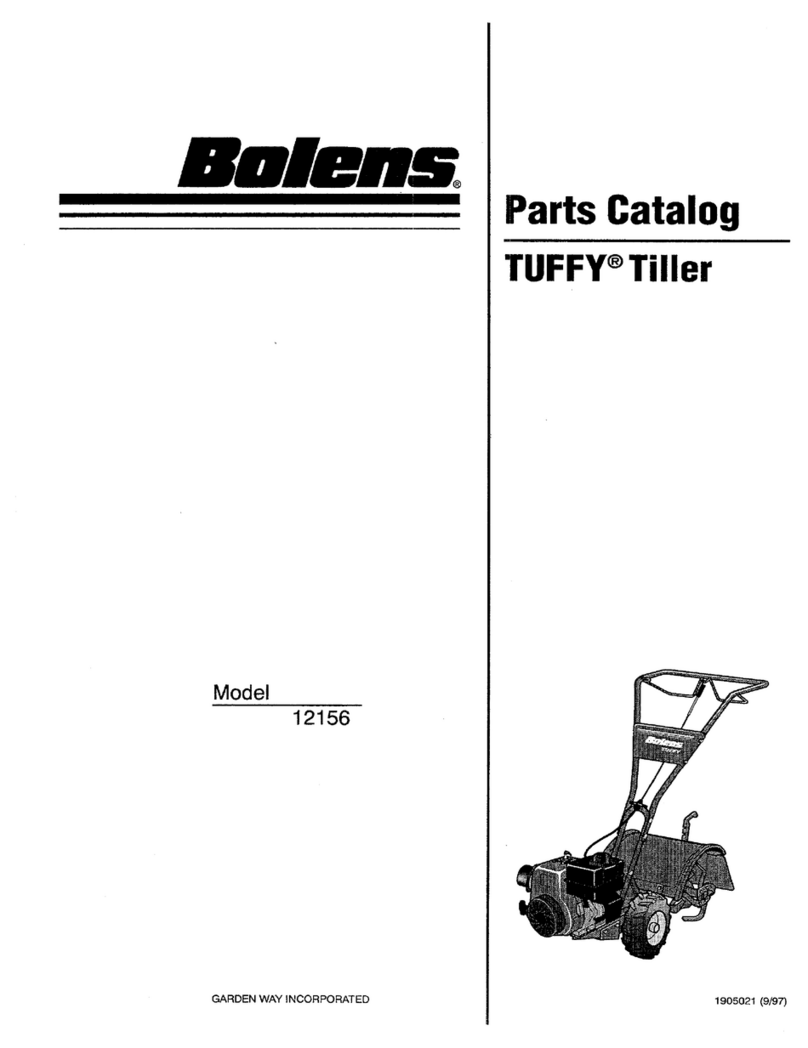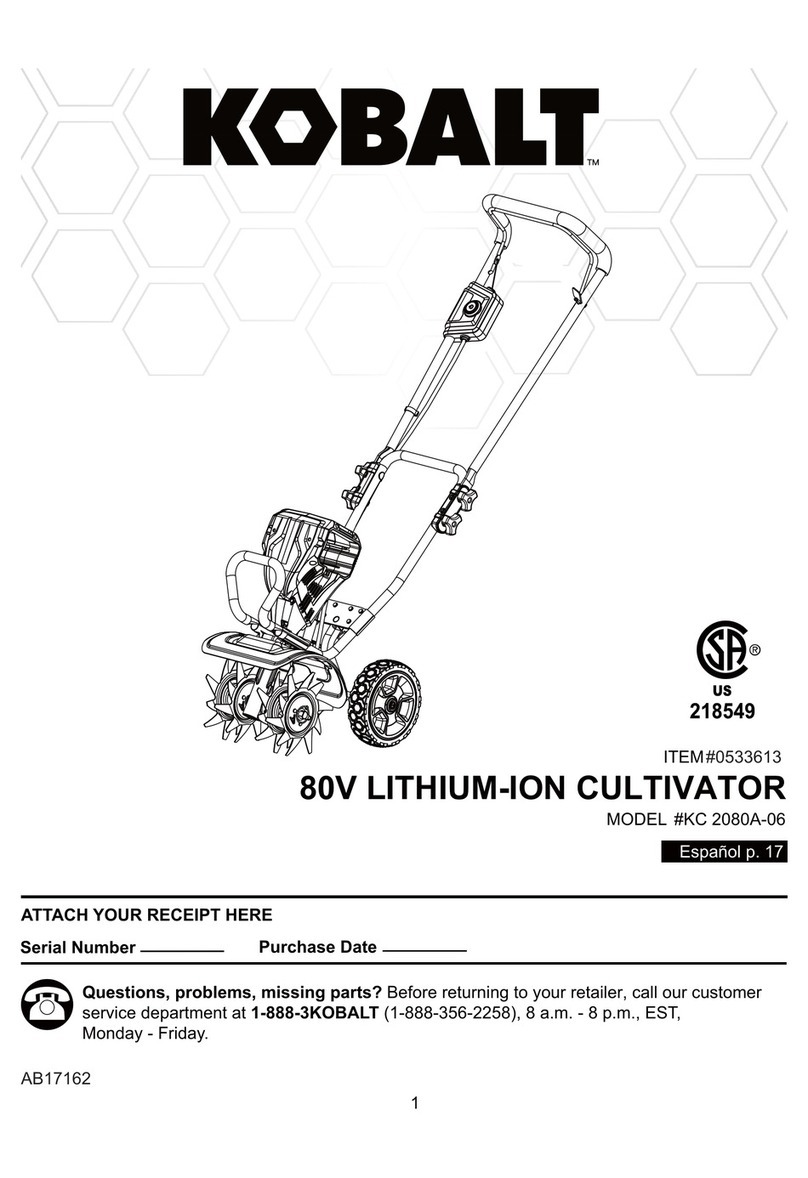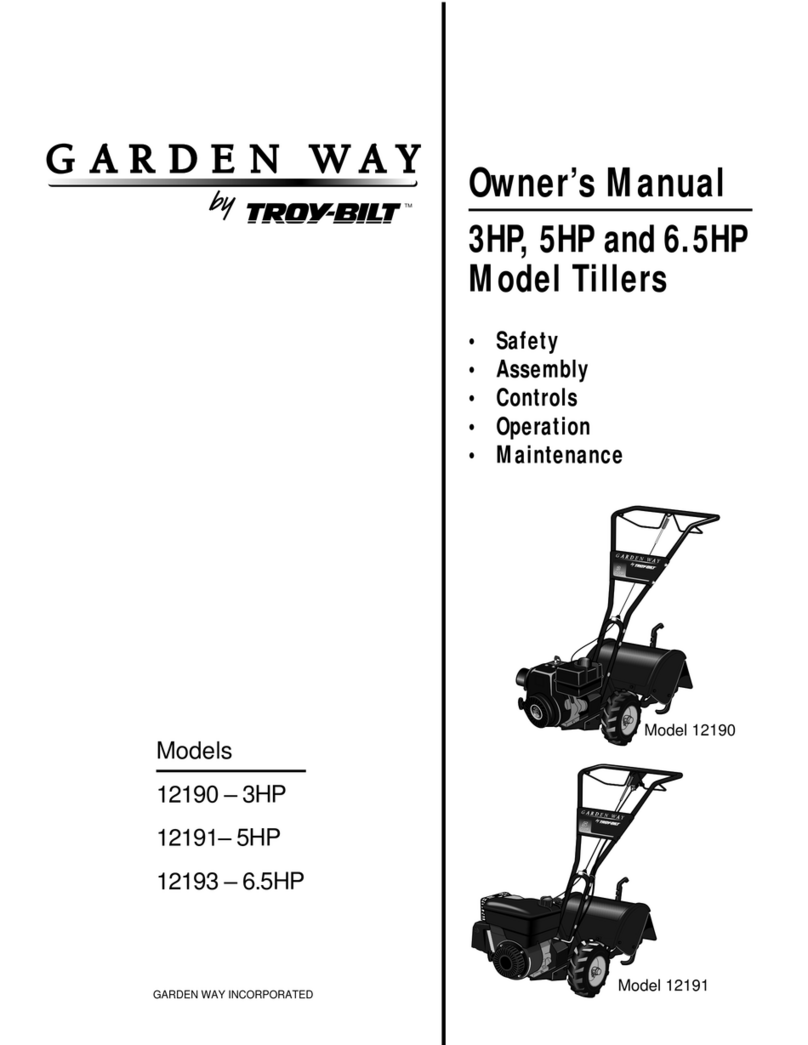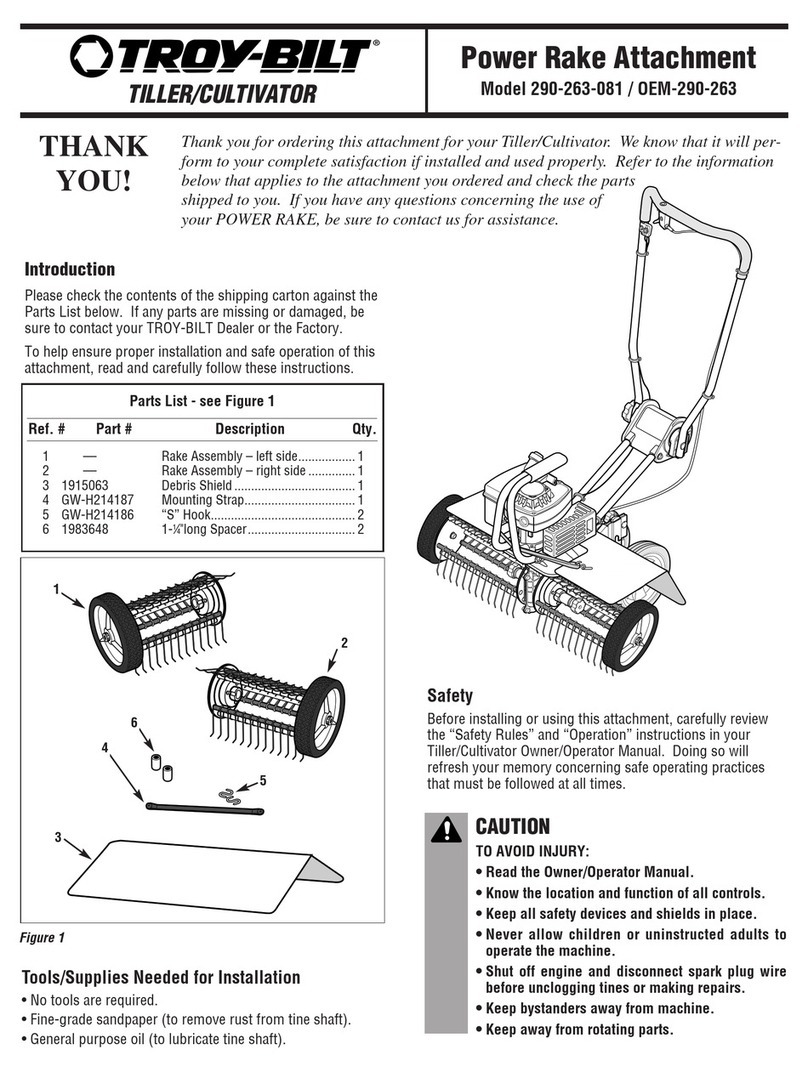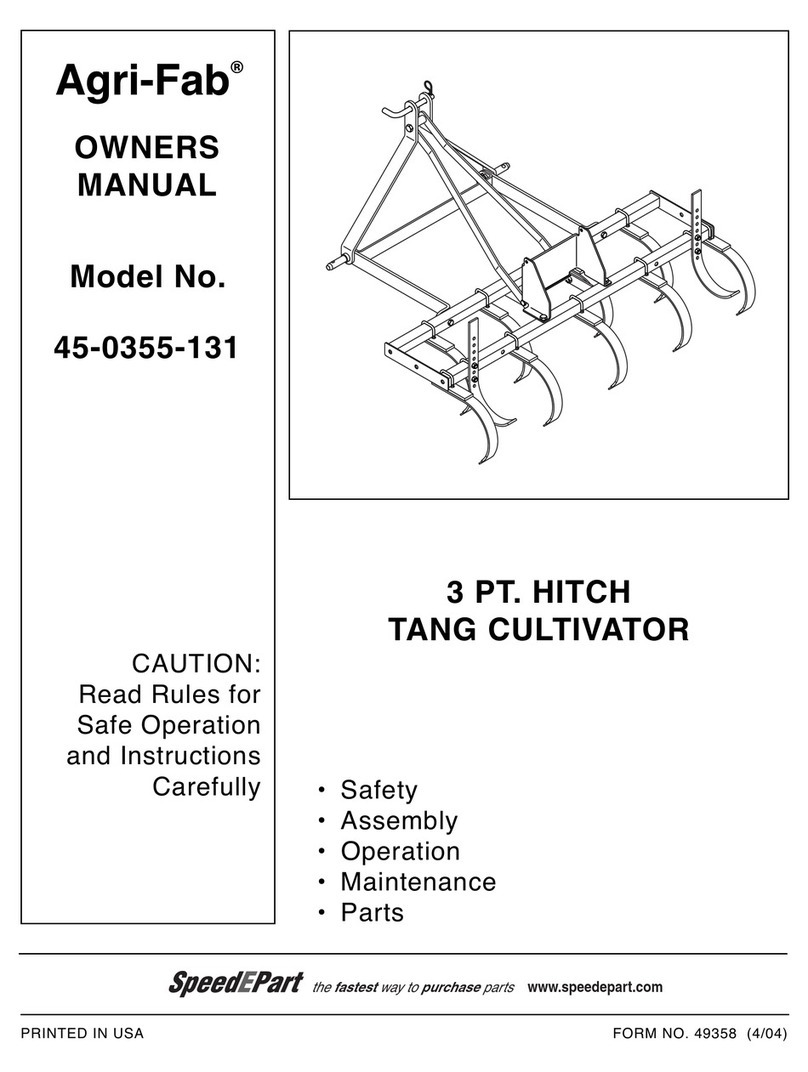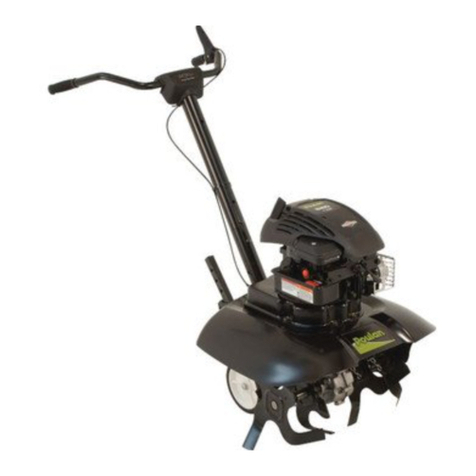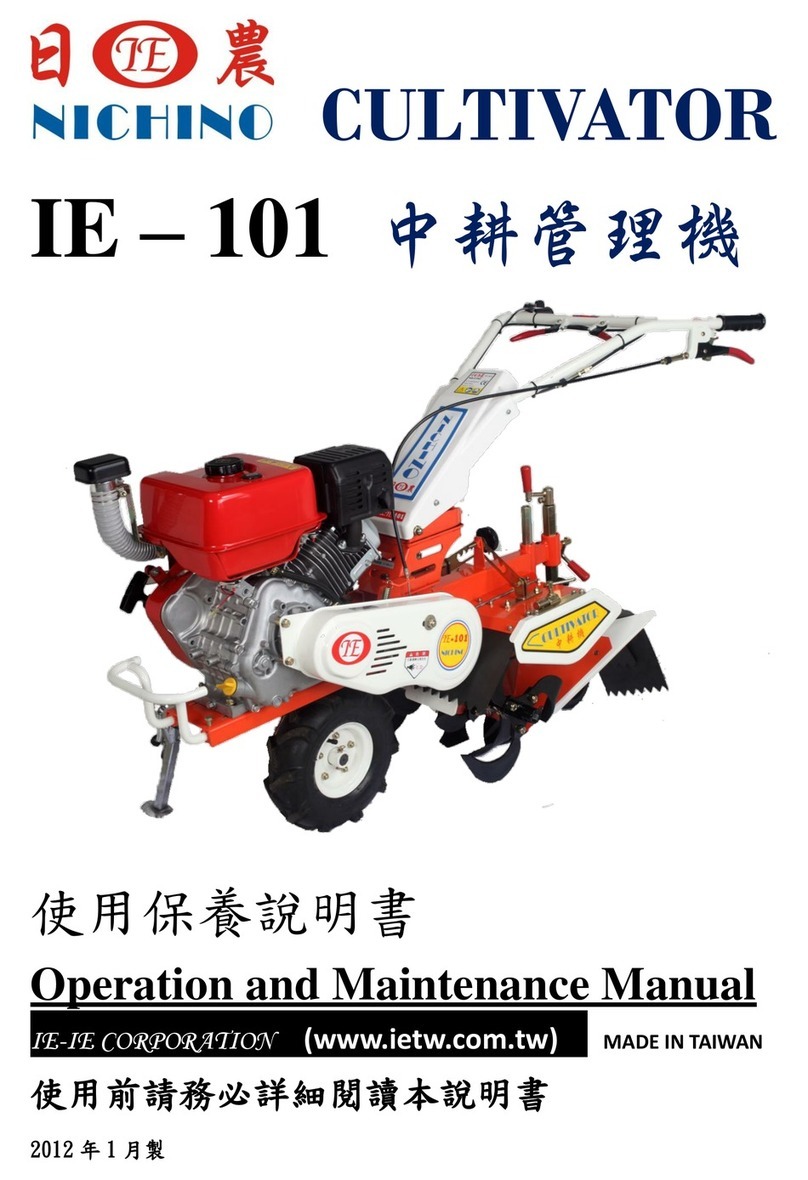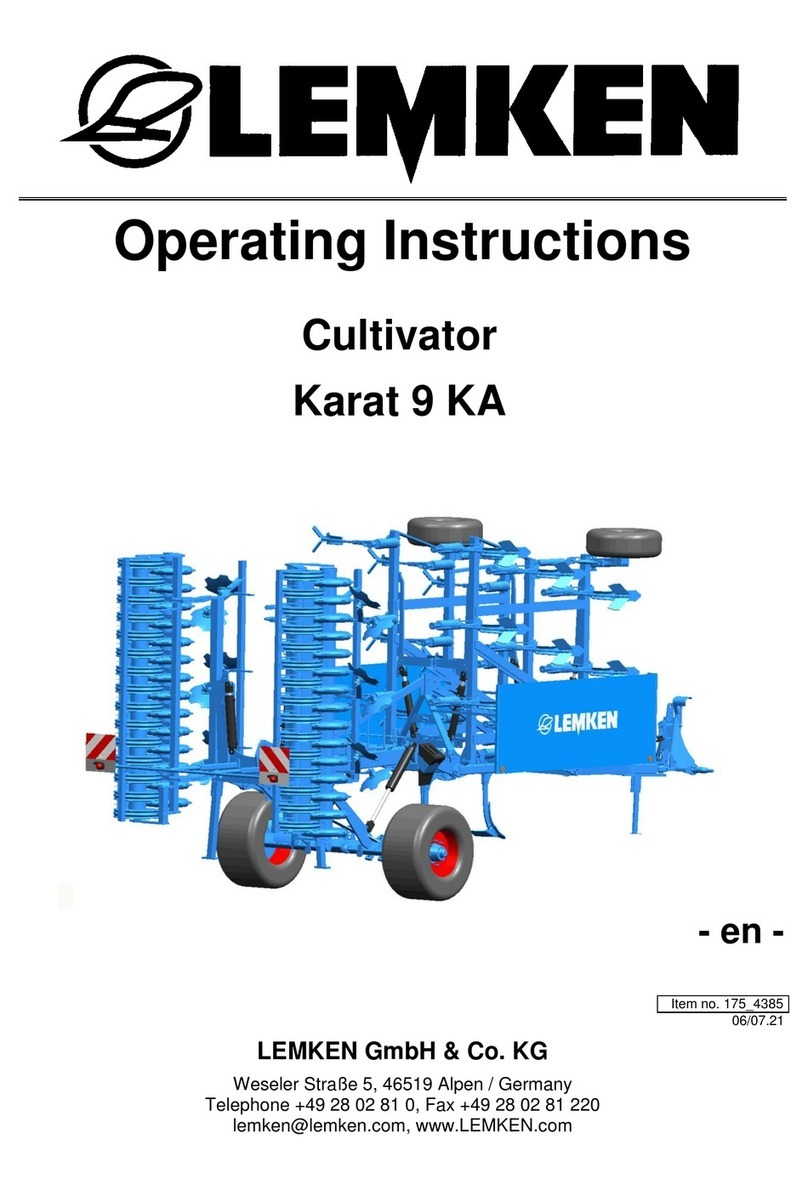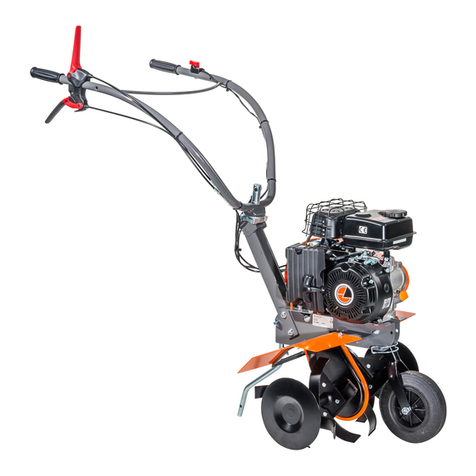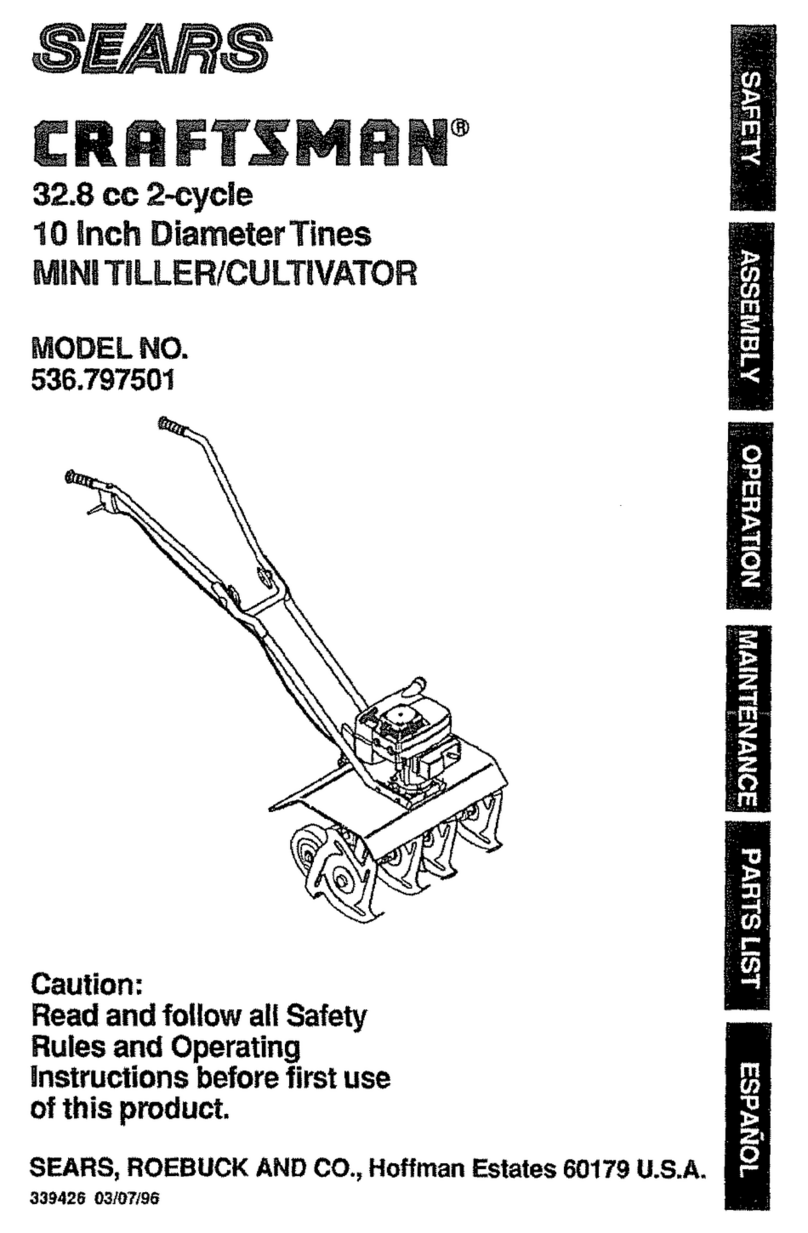elem MTBT59-CC139L User manual

Original Instructions
TILLER THERMAL
MTBT59-CC139L
S44 M11 Y2018
This machine is delivered WITHOUT OIL OR GASOLINE in the engine
Read this manual carefull before putting the unit in operation

■1. Unit
The lightweight tiller is together with a high-efficient 4 strike engine. This design is ideal for tilling
close-planted crops with semi-hard soils. When in operation, it runs steady and is quite silent.
The tiller is made of a little special wearable steel so it provides for good cost-effectiveness. A
special shape of blades provides for thrifty and efficient tilling. The turning guide wheel keeps the
tiller operation easily. tart-up system responding to a button pressing (the tiller will run upon
pressing an operation button in rest (state) improves the labor safety.
◆Scope of deliver
1. carriage
2. left-hand handle(driving lever)
3. depth limiter
4. bracket and handle
5. wheel
6. right-hand handle (on/off, speed)
7. right-hand blade
8. left-hand blade
9. Left-hand Blade protector
10. Right mudguard
11. Left mudguard
12.right-hand Blade protector
■
2. General safet instructions
Prior to the initial use of the unit, the operating instructions should be read completely. If in
doubt with regard to connection and operation of the unit, consult the manufacturer (servicing
department).This machine shall always be used in this instructions laid down in the instruction
handbook.
FOLLOW THE INSTRUCTIONS BELOW CAREFULLY IN ORDER TO SECURE A HIGH DEGREE OF
SAFETY:
CAUTION!
1. Pa attention to the conditions of the area, which ou are working in. after the engine is
started; power machine will produce poisonous flue gas. The gas may be invisible and
odorless. Hence never work with the machine closed or poorly ventilated areas. Provide for
good lighting when cutting. Provide for stability when cutting in wet, snow or icy weather
conditions on slopes or rough ground.
2. Do not let an unauthorized person approach the machine. The visitors and viewers
primarily the children, the ill and infirm persons should not have any access to the working

area. Prevent other person from any contact with the machine.
3. Make provision for the tools storage. The machines not in current use should be kept in a
dry place, elevated or locked where practicable so that any access to them is prevented.
4. Alwa s use a correct tool for the job to be done. E.g. avoid using small tools and accessories
for work that should be actually done with a heavy tool. Use the tools only for the purposes
they were designed for.
5. Pa attention to adequate clothing. The clothing should fit the purpose and should not put
any limits to you when working.
6. Use personal protection equipment. Wear safety shoes with steel toes and antiskid or rough
sole.
7. Wear goggles. Object may be thrown against you.
8. Wear ear protectors. Wear personal protective equipment to protect your ears, such as ear
protectors.
9. Hand protection. Wear hard gloves-gloves of chrome tanned side leather give a good
protection.
10. Transport. The tiller should be always transported with the driving wheel in transport
position. Make sure that nobody is exposed to risk when the tiller is put out of services.
ecure the unit against tilting, damage and fuel leakage.
11. Remove the wrench etc. Any wrenches/spanners etc. must be removed before the tiller is
put on.
12. Be attentive an time. Mind what ou are doing. Use common sense. Do not use the tiller
when tired. Never work with the cursed when influence by alcohol, drugs or medicaments
affecting the concentration capability.
13. Refueling. Always switch the engine off before refueling. Open the tank closure carefully for
overpressure run out slowly and the fuel ejaculation be prevented. When working with the
tiller, the unit body temperature increases. Let the unit cool down before refueling.
Otherwise, the fuel could ignite and persons get burnt. Beware of overfilling the tank. If there
is a spill, remove it and clean the unit. After finishing the refueling, make sure the screwed
closure is tight to avoid loosening in result of vibrations.
14. Watch out for an damaged parts. Inspect the machine before use. Are any parts damaged?
Ask yourself seriously when detecting slight damage whether the machine will work perfectly
and safely despite that. Watch out for proper aligning and adjustment of any moving parts.
Do the parts fit one in another properly? Are the part damaged? Is everything installed as
appropriate? Are any other prerequisites of proper working in place? Damaged protective
devices etc. must be repaired or replaced by authorized entities unless the operation manual
expressly says otherwise. Any defective switches must be replaced at an authorized servicing
centre. Do not use the machine if it can’t be put on and off with the switch. When repairs are
necessary, kindly turn to your local servicing centre :
15. Switch the engine off before an adjustment and maintenance. That applies to the blades
replacement in the first place.
16. Use approved parts onl . Use only identical spare parts for maintenance and repairs.
Request advice of an authorized servicing centre for this purpose.
1) training
a) Read the instructions carefully. Be familiar with the controls and the proper use of the
equipment;
b) Never allow children or people unfamiliar with these instructions to use the machine.
Local regulations can restrict the age of the operator.

c) Never work while people, especially children, or pets are nearby;
d) Keep in mind that the operator or user is responsible for accidents or hazards occurring
to other people or their property.
2) Preparation
a) While working. Always wear substantial footwear and long trousers. Do not operate the
equipment when barefoot or wearing open sandals;
b) Thoroughly inspect the area where the equipment is to be used and remove all objects
which can be thrown up by the machine;
c) WARNING – Petrol is highly flammable;
tore fuel in containers specifically designed for this purpose
-Refuel outdoors only and do not smoke while refueling;
-add fuel before starting the engine. Never remove the cap of the fuel tank or add petrol
while the engine is running or when the engine is hot;
-If petrol is spilled, do not attempt to start the engine but move the machine away from
the area of spillage and avoid creating any source of ignition until petrol vapor has
dissipated;
-Replace all fuel tank and container caps securely;
d) Replace faulty silencers;
e) Before using, always visually inspect to see that the tools are not worn out or damaged.
Replace worn out or damaged elements and bolts in sets to preserve balance.
3) Operation
a) Do not operate the engine in a confined space where dangerous carbon monoxide fumes
can collect;
b) Work only in daylight or in good artificial light;
c) Always be sure of your footing on slopes;
d) Walk, never run with the machine;
e) For wheeled rotary machines, work across the slopes, never up and down;
f) Exercise extreme caution when changing direction on slopes;
g) Do not work on excessively steep slopes;
h) Use extreme caution when reversing or pulling the machine towards you;
i) Do not change the engine governor settings or over speed the engine;
j) tart the engine carefully according to manufacturer instructions and with feet well away
from the tool(s);
k) Do not put your hands or feet near or under rotating parts;
l) Never pick up or carry a machine while the engine is running;
m) top the engine:
-Whenever you leave the machine;
-Before refueling;
n) Reduce the throttle setting during engine shut down and, if the engine is provided with
A shut-off valve, turn the fuel off at the conclusion of working;
4) Maintenance and storage
a) Keep all nuts, bolts and screws tight to ensure the equipment is in safe working
condition;
b) Never store the equipment with petrol in the tank inside a building where fumes can
reach an open flame or spark;
c) Allow the engine to cool before storing in any enclosure;
d) To reduce the fire hazard, keep the engine, silencer, battery compartment and petrol

storage area free of vegetative material and excessive grease;
e) Replace worn or damaged parts for safety;
f) If the fuel tank has to be drained, this shall be done outdoors.

SYMBOLS
Denotes risk of personal
injury or damage to the
tool.
Read manual before use
Wear goggles and ear
defenders when using the
device.
Wearing of protective
shoes advised
Wear gloves
Engine exhaust contains
carbon monoxide, Never
operate the product in an
enclosed area!
No naked flame
No smoking
Flammable. Do not fill fuel
tank in an enclosed area
or while unit is running.
Allow engine to cool at
least 2 minutes before
re-fueling.
Risk of injury caused by
rotating machine parts!
Clutch handle released,
unit is running in idle.
Choke, cold start setting
Maximum motor
revolutions
Minimum motor
revolutions.
Add engine oil.
Hot! Do not touch exhust
system or engine until cool
Risk of injury due to flying
parts! Always maintain a
sufficient safety distance
Risk of projections.
There is a risk of flying
objects while using the
machine.
Clutch handle pulled, tine
turns
Motor off

When repairing, please
take out the spark plug.
Then repair according to
the operation manual.
EC accordance with
European standards of
safety enforcement
Stop the engine
before refueling
Guaranteed sound
power
◆2.1 Emergenc action
Apply the first aid adequate to the injury and get qualified medical assistance as quickly as
possible. Protect the injured person from more accidents and calm him/her down.
◆2.2 Assigned use
The unit is designed only for regular use in agriculture, forestry, and horticulture and area
treatment. The manufacturer should not be held liable for any personal and material losses
due to a failure to observe these rules.
◆2.3 Residual hazards and protective action
2.3.1 Mechanical residual hazards
Hazard description protective Residual hazards
Incision, cutting Rotating blades may
cause severe incisions
or cut a part of body
off.
Always wear protection
gloves when working with
the unit. Never reach in
when the unit is running
Catching, winding
up
Cords, wires or parts of
garments may be
caught by the spud and
pulled in.
Remove any foreign objects
from the land and keep
distant from the teeth and
wear tight-fitting clothes.
2.3.2 Electrical residual hazards
Hazard Description Protective Residual hazards
Direct electrical
contact
Contact with the ignition
plug when the engine is
running may result in an
electrical shock
Do not touch the plug
socket while the
engine is running
2.3.3 Thermal residual hazards
Hazard Description Protective Residual hazards
Bums, frost bites Contact with exhaust
may cause burns

2.3.4 Noise hazard
Hazard Description Protective Residual hazards
Hearing impairment Frequent or prolonged work
with unit without wearing ear
protectors may result in
hearing impairment
Wear ear
protectors
2.3.5 Vibration hazard
Hazard Description Protective Residual hazards
Entire body
vibration
Working with the unit for
a prolonged period may
affect human organism
due to the vibrations
Have regular breaks
2.3.6 Material and other substances hazards
Hazard Description Protective Residual hazards
Contact, breathing
in
Breathing in exhaust
gases may be hazardous
for health
The unit should be
used outdoors only
Fire or explosion The unit is used with
easily ignitable mixture
that may ignite in the
course of refueling
Don’t refuel near
open fire.
Do not smoke while
filling
2.3.7 Other hazards
Hazard Description Protective Residual hazards
Thrown objects or
splashed liquids
Thrown objects or soil
may cause injury.
Pay attention to the work
area free of any persons.
Wear personal protective
equipment
2.3.8 Disposal
Disposal instructions are given by pictographs on the unit or packaging. For meaning of
individual symbols refer to chapters on unit.
◆2.4 Operator requirements.
The operator shall read the instruction manual carefully before using the unit.
2.4.1 Qualification
No special qualification is required for use of the unit except for detailed direction by a
professional.
2.4.2 Minimum age
Only persons above 16 years of age are allowed to work with unit.
Exempted from the provision is the use of the juvenile trainees if they work in the course of
their professional training with an aim to obtain the skill under trainer supervision.

2.4.3 Training
Use of the unit requires adequate lesson by a professional or the use of the manual only.
pecial training is not required.
■3.Technical data
Engine design 4 strike OHV
Max. rotational speed
n
0
:3000 min
-1
Engine displacement
2,6 kW/139cm³
Working width
590 mm Max. – 360mm Min.
pud
4 x Φ26 cm
Forward run 1
Fuel/tank volume 1.5L
Volumes of lubricating oil tank 0.6L
SAE 10W40
tarting system Reverse starter
Guaranteed sound power level 93dB(A)
Gross weight
35 kg
(L
PA
) 77.3 dB(A) (L
WA
) 93 dB(A) K 3 dB(A)
ATTENTION !
The sound power pressure may exceed 85 dB(A), in this case
individual hearing protection must be worn.
Weighted root mean square acceleration according to relevant standard : 3.548 m/s² K = 1.5 m/s²
The declared vibration total value has been measured in accordance with a standard
test method and may be used for comparing one tool with another that the declared vibration
total value may also be used in a preliminary assessment of exposure.
A warning that the vibration emission during actual use of the power tool can differ
from the declared total value depending on the ways in which the tool is used and of the need to
identify safety measures to protect the operator that are based on an estimation of exposure in
the actual conditions of use (taking account of all parts of the operating cycle such as the times
when the tool is switched off and when it is running idle in addition to the trigger time).
NOTE: This product is not intended for professional use.

■4.Tansportation and storage
●The unit is allowed to be transported with the engine off only.
●Clean the unit thoroughly before putting in on storage.
●tore the unit at a dry clean place.
■5.Assembl
tructural group 1
Delivery –contained
Parts and
accessories
Fig 1 – pos.1
Fig 1 – pos.4
tructural group 2
Required structural
groups
Delivered parts and
accessories
tructural group 1
Fig 1 – pos.6

tructural group 3
Required structural
groups
Delivered parts and
accessories
tructural group 2
Fig 1 – pos.5
tructural group 4
Required structural
groups
Delivered parts and
accessories
tructural group 3
Fig 1 – pos.2
Fig 1 – pos.7
tructural group 5
Required
structural groups
Delivered parts
and accessories
tructural group 4
Fig 1 – pos.3

Flg.8
Refueling
Use only regular leadless petrol
Explosion hazard!
Refuel outdoors only!
Never refuel with engine running or while it is
still hot!
Do not smoke and do rot handle open fire.
Engine oil filling
Use only oil type 15W40!
Use oil dip rod to check the filling status.
Avoid fuel or oil splashing so that soil
contamination is avoided. Use appropriate tools
for filling(funnel)
◆5.1 safet instructions for the first putting in operation
Always make sure that the screwed parts are tight as appropriate and use only the parts
included in the delivery.
◆5.2 procedure
Assemble separate parts in the correct order as shown. Make sure that structural parts
are arranged as shown in figures.
the unit is delivered without oil and fuel. Fill in the liquids according to specifications.
■6. OPERATION
Guiding wheel in work position
Put the wheel in pos. 1 for working.
CAUTION!
Transport the unit with the wheel in pos.2
The wheel can be adjusted with engine off
only!
Cutting height setting
hifting the depth limiter shall set up the
required depth of tilling. 5 different
positions are possible.

witching unit on/off
Put the lever on the chute (fig.11).pull the
starter cable evenly. The engine should
start up after 3-5 pulls. Put the lever at the
required speed and pull the driving lever
(fig 11) against the handle (fig.12).
Notice: if the engine is heated up, it is
possible to start up in the slow/fats
position.
With the driving lever tripped, the drive
will be off but the engines works on. The
engine may be switched off with the
switch in OFF position (fig.11).
When starting up the engine, the unit
should not be titled, only on the side
reverse to the operator if necessary for the
start.
◆6.1 OPERATOR SAFETY INSTRUCTION
●Do not use the machine until you have read the instruction manual carefully.
●Observe any safety instructions included in the manual.
●Be responsible to the others.
●The unit is provided a foot-operated brake than stops the blades within 3 seconds after
the drive lever tripping. Never attempt stooping the unit or tilting the unit with blades
still rotating. Wait for the blades to come stand still by themselves.
●If the blades get in contact with foreign objects stop the engine immediately and check
the unit with blades stopped for damage. Continue working with unit undamaged only.
●Walk while working, do not run.
●Always walk forwarder only. Never pull the unit walking backwards.
●When working on a slope, always work across, never down and up. Be particularly
carefully when changing direction.
●When travelling across no-grass areas and transferring the unit from the work area to
another one, the blades must not be operating.
●Always holding tighten the clutch which allow the machine to be handle by your two
hands .
◆6.2 STEP BY STEP INSTRUCTIONS
1. Fill in the fuel (see chapter assembly and first putting in operation
2. Clear any foreign objects from the land.
3. pud the land until the soil is sufficiently loose.
4. Clean the unit thoroughly after every use.

■7. TROUBLES-CAUSES-TROUBLESHOOTING
Trouble Cause Troubleshooting
Engine will not
start
1. Empty tank
2. fouled air filter
3. no ignition spark
4. flooded engine
1. fill in the tank, check the fuel in
carburetor, defecate the tank and
clean the hole in the lid with a needle
2. clean the air filter
3. clean the ignition plug or use a new
one, check the ignition cable, have the
ignition system checked in a servicing
shop
4. remove the plug, clean and wipe dry,
pull the starting cable several times
with the plug removed
Faltering engine 1. ignition cable detached
2. fuel piping clogged or
wrong fuel
3. blocked hole in the fuel
tank cover
4. water or dirt in fuel
system
5. fouled air fitter
1. push the plug, socket firmly on the
plug
2. clean fuel piping, use fresh/different
fuel replace the fuel tank cover
3. drain the fuel and refuel
4. clean the air filter
Engine often
switches off when
idling
1. too long ignition interval,
defective ignition plug
2. carburetor not set
correctly
3. fouled air filter
1. adjust/replace the ignition plug
2. set up the carburetor
Drive will not
work properly
1. check the drive lever
cable tension
2. drive does not work
1. adjust the cable tension if necessary
2. have the unit checked in a servicing
shop
Excessive
vibrations
1. loose lock screws 1. tighten the lock screws

■8. INSPECTIONS AND MAINTENANCE
◆8.1 INSPECTIONS AND MAINTENANCE SAFETY INSTRUCTIONS
The machine will serve as a sufficient aid only if maintained and care for appropriately.
Insufficient maintenance and care may result in accidents and injuries.
●Prior to an works on the unit, alwa s switch the engine off and pull the sparkle plug
socket out!
●Never use aggressive detergent for cleaning. That could result in damage or destruction
of the unit.
◆8.2 INSPECTION AND MAINTENANCE SCHEDULE
Time interval Description Other details if necessary
Before start of work Check the engine oil level
(see figure)
Check for any loosen parts
Every 25 operating hours Exchange the engine oil
Check the engine oil level
Clean the air filter (see
figure)
Remove remnants of grass
from rotation parts with a
brush or a blunt tool.
Wipe the body with a soft
cloth
When the dirt is hardened,
the unit may be cleaned with
soft cloth wetted in soapy
waters
Every 100 operating hours Check, clean or replace the
ignition sparkle plug.

SERVICE DEPARTMENT
_ Damaged switches must be replaced by our after-sales service department.
_ If replacing the power cord is necessary, it should be done by the manufacturer or his agent to
avoid a hazard.
After-sales Service and Application Service
Our after-sales service responds to your questions concerning maintenance and repair of your product
as well as spare parts. Exploded views and information on spare parts can also be found
under:
www.eco-repa.com
ELEM GARDEN TECHNIC application service team will gladly answer questions concerning our
STORAGE
Risk of fire !
Store your Electric Hoe away from fuels, oils,
grease and gases.
_ Thoroughly clean the whole machine and its accessories.
_ Store it out of the reach of children, in a stable and secure position, in a cool and dry place, avoid too
high and too low temperatures.
_ Protect it from exposure to direct sunlight. Keep it in the dark, if possible.
_ Don’t keep it in plastic bags to avoid humidity build-up.
At the end of the season, perform a general inspection of the machine and remove any deposits
which may have accumulated. At the start of each season, ensure that you check the condition of the
machine. If repairs are necessary, please contact one of our customer service centers (see address on
warranty certificate).
GUARANTEE
Refer to the enclosed guarantee conditions for the terms and conditions of guarantee.
Made in China 2017



GB
Declaration of Conformity
We “ELEM GARDEN TECHNIC” hereby declare that the machine described below complies
with the relevant basic safety and health requirements of the EU Directives, both in its basic design and
construction as well as in the version put into circulation by us. This declaration shall cease to be valid if
the machine is modified without our prior approval.
Product:
TILLER THERMAL
Type: MTBT59-CC139L
SN : 2018.11 :001~396
Relevant EU Directives
2006/42/EC(MD) - 2014/30/EU(EMC)
2005/88/EC(NOISE) - 2010/26/EU(GAS)
Applied harmonized standards
EN 709 :1997/A4 :2009
AfPS GS 2014 :01 PAK
EN ISO 14982 :2009
EN ISO 3744 :1995
ISO 11094 :1991
Technical Data
Product: TILLER THERMAL
Type: MTBT59-CC139L
2,6 kW/139cm³
L
pA
: 77.3dB(A) K=3 dB(A)
L
WA
: 93 dB(A) K=3 dB(A)
3.548 m/s² K = 1.5 m/s²
ELEM GARDEN TECHNIC
81 rue de Gozée 6110 Montigny-le-Tilleul Belgique
Belgium, November 2018
Mr Joostens Pierre
Director
ELEM GARDEN TECHNIC, rue de Gozée 81,
6110 Montigny-le-Tilleul, Belgique
Tél : 0032 (0) 71 29 70 70
Fax : 0032 (0) 71 29 70 86
SN : 2018.11 :001~396
31.10.12611
Arrival date
: 21/01/2019
Production year :
2018

81, rue de Gozée
6110 Montigny-le-Tilleul
Belgique
Tél : 0032 71 29 70 70 Fax : 0032 71 29 70 86
Made in China
S.A.V
sav@eco-repa.com
Service Parts separated
32 / 71 / 29 . 70 . 83 32 / 71 / 29 . 70 . 86
Made in China 2018
Drawings, descriptions and photos are non-contractual and subject to change.
Table of contents
